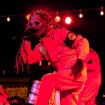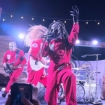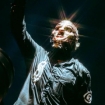With the exception of Eighties glam, no hard-rock subgenre has been more critically reviled — or found more chart success — than the nu-metal that dominated the airwaves during our most recent millennial shift. Fusing Nirvana's trademark dynamics with influences from hip-hop and electronic music, nu-metal was brash, funky and free of the hand-wringing guilt that kept flannel's most visible flag-flyers from embracing their stardom. Though the scene was populated with numerous one-hit wonders who rose to fleeting fame on the backs of big singles, many of the albums that came out of the movement still stand the test of time. It makes sense, then, that the sound is having a resurgence today, at the hands of rising bands like Vein.fm and Cane Hill as well as rappers such as City Morgue for whom it served as an important gateway to sonic excess.
Coal Chamber - Coal Chamber
Coal Chamber may have looked more like industrial goths at the warehouse rave than nu-metal moshers in the Ozzfest pit, but don't judge a coal by its chamber. Led by future DevilDriver frontman Dez Fafara, the L.A. band's 1997 self-titled debut rages somewhere between the rabbit-like springiness of Korn, the ragged grooves of Sepultura and the apoplectic rap-metal tantrums that would become Slipknot's calling card a couple years down the pike. "Loco" is the hit, but other cuts like "Oddity" and "Big Truck" will scratch that itch for the genre's heavier, more confrontational early days.
Deftones - Around the Fur
Syncopated riffs, big pants and goofy band names are nu-metal trademarks, and Deftones initially fit the bill, but when singer Chino Moreno opened his mouth on this remarkable second album, he uncorked a haunting, sexually ambiguous edge that owes more to Eighties dream-pop groups like the Cure and Cocteau Twins — both of whom the Sacramento-bred band later covered. The result was the first true Deftones album, setting the stage for their future triumphs and never-ending evolution.
Disturbed - The Sickness
Disturbed nailed their signature formula on the very first try. The Chicago band's 2000 debut, The Sickness, is loaded with crunchy, sturdy, bounce-able riffs that sound like they were designed in a lab to get concertgoers jumping and gym rats bench-pressing. David Draiman's unique baritone voice is certainly polarizing — even more so on later albums when the band dipped into power balladry and his croon became the focus — but beyond the ubiquitous "Down With the Sickness," The Sickness offers a surprising amount of variety (speckles of industrial metal abound) and plenty of headbanging fodder.
Incubus - S.C.I.E.N.C.E.
Before frontman Brandon Boyd gave up on shirts entirely and his Cali band found soft-rock chart success, Incubus were be-dreaded, fun-in-the-sun spazzes, mashing together metal, funk, hip-hop, trip-hop, jazz and more on their sophomore album S.C.I.E.N.C.E. Cuts like "Vitamin," "Idiot Box" and "A Certain Shade of Green" have been live staples ever since, and for good reason: They might be heavier than the group's more recent fare, but they're no less hooky and full of refreshingly good vibes.
Kittie - Spit
Kittie's core sister duo of Morgan (vocals, guitar) and Mercedes Lander (drums) were just 17 and 15, respectively, when the band dropped its breakthrough debut album, Spit, which made brash, no-holds-barred songs like "Do You Think I'm a Whore" and "Get Off (You Can Eat a Dick)" all the more shocking and hard-hitting. Over 20 years later, the group's take-no-shit attitude, primal playing and mix of little-girl sing-song and I-am-woman roars align them as much with Nineties riot-grrrl firestarters like Babes in Toyland, L7 and Hole as it does nu-metal.
Korn - Korn
"Are you ready?" Jonathan Davis roars at its open, and a generation of pissed and pained kids were. When it dropped the year Kurt Cobain killed himself, Korn's debut was so undeniably funky, emotionally raw and impossibly heavy that even death-thrash masters Sepultura wanted to follow these new metal leaders (see Roots, below). Many years later, ferocious yet dense and nuanced cuts like "Blind" and "Faget" still get the mosh pit going with virtually unmatched cathartic power.
Limp Bizkit - Three Dollar Bill Y'all $
When they first hit the scene — before Fred Durst became the universe's Frat Boy in Chief and the most hated man in metal — Limp Bizkit were scrappy, off-kilter rap-rock weirdos, setting freak-and-geek guitar hero Wes Borland's squealing art-noise riffage against Durst's A.D.D. white-boy freakouts. Three Dollar Bill's punky George Michael cover was the band's first hit, but more abrasive cuts such as "Stuck" and "Pollution" are the real standouts — raw, shambolic and hyperactive with genuine vitriol.
Linkin Park - Hybrid Theory
Where their peers dabbled in hip-hop, Linkin Park had genre credibility in MC-producer-designer-guitarist Mike Shinoda; they also had a singer, in the charismatic Chester Bennington, with legit vocal chops. It may have been his hooks on irresistible songs like "Crawling" and "In the End" that made Linkin Park's gazillion-selling debut such a smash, but the band as a whole also proved itself as a boundary-destroying force to be reckoned with.
Mudvayne - L.D. 50
With L.D. 50 — executive-produced by Slipknot's Shawn "Clown" Crahan — Mudvayne took critical flak for their gimmicky carnivalesque image, but the album's prog-rock experimentalism holds up amazingly well. Indeed, even as Chad Gray's rapped vocals on tracks like "Under My Skin" bind L.D. 50 to nu-metal, the LP's knotty compositions, virtuosic playing and heady lyrics situate it within the "math-metal" classification that the band embraced in its early days.
Mushroomhead - XIII
The masks make them hard enough to take seriously, but add in the success of longtime rivals Slipknot — which will forever relegate this Ohioan group to being metal's other masked maniacs — and Mushroomhead have serious disadvantages when it comes to winning critical respect. An underrated nu statement, XIII is textured, ambitious and hook-laden, with cuts such as "Nowhere to Go," "One More Day" and "Almost Gone" seething and swerving like vintage Faith No More, while "The War Inside" boasts the incomparable body-banging presence of Meshuggah singer Jens Kidman adding to its burly pummel.
Orgy - Candyass
Korn's Jonathan Davis was such a big fan of Orgy's swirling, gothy "death-pop," he signed them to his label Elementree, sang on their song "Revival" and took them out on the first-ever Family Values Tour. On the strength of such support and the band's crunchy cover of New Order's "Blue Monday," Candyass, their debut, went platinum, but it stands up on its own merits, as well — a dark monolith of lipstick-smeared Manson-esque glam and debauched Eyes Wide Shut insinuation.
P.O.D. - Satellite
Nu-metal's first outspokenly Christian act, P.O.D. exchanged the gnarlier hardcore of early albums like 1996's Brown for hook-heavy, reggae-infused rap-rock on this, their Bad Brains vocalist H.R.–assisted fourth studio album. The group was rewarded with multiplatinum success for their efforts, and the rousing singles "Alive" and "Youth of a Nation" became survivors' anthems for 9/11 and Columbine, respectively.
Sepultura - Roots
A polarizing creative and commercial breakthrough akin to Metallica's "Black Album," Sepultura's Roots saw the Brazilian band draw on far-flung influences — from the aforementioned Korn, to their homeland's indigenous tribal culture — to make something altogether original, unexpected and endlessly influential, even to one Dave Grohl, who has admitted A-B'ing his records against it. Savage and punishing yet spiritual and uplifting, Roots also boasts the distinction of bringing together proto-nu-metal hero Mike Patton and his acolyte Jonathan Davis together on one track, the atmospheric "Lookaway."
Sevendust - Sevendust
After cycling through monikers — first Rumblefish then Crawlspace and finally Sevendust — this Atlanta, Georgia, crew quickly made their name with their grooving self-titled debut. When it dropped in April of 1997, most critics lazily compared Sevendust to Living Colour. But dynamic and crushing numbers like "Black," "Bitch" and "My Ruin" (the last, originally released under the Crawlspace tag) demonstrated that vocalist Lajon Witherspoon and Co. had much more in common with post-thrash Metallica and inadvertent nu-metal forefathers Faith No More.
Slipknot - Slipknot
The 'Knot exploded out of the heartland of America like a dirty bomb with their self-titled debut, the perfect antidote to the increasingly formulaic pop cheesiness of the nu-metal scene. Cuts like "(sic)," "Eyeless," "Spit It Out" and "Surfacing" spat in the face of the backwards-red-baseball-cap crowd, while "Wait and Bleed" proved the Nine had the songwriting chops to reel out a radio-friendly hit or two — if that's what it took to expand their cult.
Snot - Get Some
While most of their late-Nineties peers were painting from a palette of groove-metal, funk-metal and raucous hip-hop, Snot splattered their nu-metal canvas with globs of hardcore punk. The Santa Barbara, California, band's first and only album with original vocalist Lynn Strait is a coveted and vastly underrated gem that folds the rap-metal fury of early Rage Against the Machine with Cali-punk power chords, straight-up "woah-oh" gang chants and a twinge of stoner-metal swagger.
Soulfly - Soulfly
After Sepultura splintered at the peak of their power and popularity, main man Max Cavalera went his own way, following the nu-metal left turn of Roots deeper into the wilderness with Soulfly — a band that found its name in "Headup," the singer-guitarist's 1997 collaborative track with the Deftones. The group's self-titled debut is a wide-ranging affair, featuring cameos by a late-Nineties alt-metal who's who — Chino Moreno, Limp Bizkit's Fred Durst and DJ Lethal, Fear Factory's Burton C. Bell and Dino Cazares and others — and spanning from the punky Hootie & the Blowfish tell-off "No," to the tribal instrumental title track, to the furious bounce of "Eye for an Eye."
Spineshank - Strictly Diesel
On their largely overlooked debut album, Spineshank found the sweet, strange spot between a less-death-metal Fear Factory and a more-aggro Orgy (fitting reference points since the former's Burton C. Bell and the latter's Amir Derakh both make cameos on Strictly Diesel). But the most accurate comparison might be to an industrialized Deftones, especially in frontman Jonny Santos' Chino Moreno-esque vocals, veering between excoriating shrieks and silky crooning. Come for slappers like "Intake" and "Shinebox," stay for the surprisingly effective cover of the Beatles' "While My Guitar Gently Weeps."
Static-X - Wisconsin Death Trip
Though frontman Wayne Static's towering hairdo sometimes overshadowed his band's creative output, Static-X's irresistibly syncopated and beautifully streamlined debut album brought a fun industrial danceability to nu-metal's down-tuned sturm und drang. The band wouldn't match the minimalist sublimity of rafter-shaking bangers such as "Push it," "Bled for Days" and "Fix" over the course of its five following LPs, and with Static's death in 2014, all chance of that ever happening vanished.
System of a Down - Toxicity
Technically spotless, wildly eclectic and proudly Armenian, System of a Down turned nu-metal on its ear with their 1998 self-titled debut, and with this darker and more streamlined follow-up, the band proved that they were way more than just a novelty. Spastic lead single "Chop Suey!" is still one of the most awesomely bizarre songs to ever get repeated play on the radio. Wake up, indeed.












